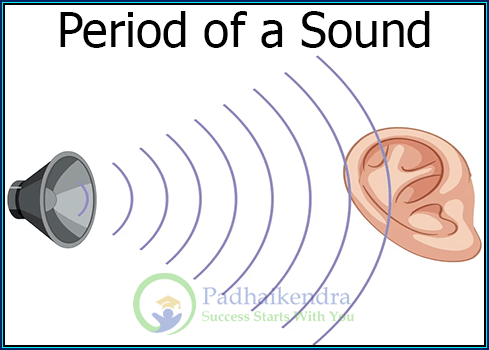Amplitude of a Wave
The amplitude of a sound wave is the measure of the maximum displacement of particles in a medium from their rest position. In simpler terms, it is the height of a sound wave measured from the middle to the top of a crest or from the middle to the bottom of a trough. The amplitude of a sound wave is represented by the vertical distance of the wave from the middle line or the x-axis.
What is Period of Sound
The formula for the period of sound is:
T = 1/f
Where T represents the period of sound in seconds and f represents the frequency of sound in hertz (Hz).
In simple terms, the period of sound is the time taken by a sound wave to complete one cycle, while frequency is the number of cycles completed by the sound wave per second. Therefore, the period and frequency of sound waves are inversely proportional to each other.
For example, if the frequency of a sound wave is 100 Hz, then the period can be calculated as:
T = 1/100 T = 0.01 seconds
Similarly, if the frequency of a sound wave is 500 Hz, then the period can be calculated as:
T = 1/500 T = 0.002 seconds
What is Frequency of Sound
Frequency of sound refers to the number of vibrations or cycles per second that a sound wave completes as it travels through a medium. It is measured in Hertz (Hz).
For example, a sound wave that completes 500 cycles in one second has a frequency of 500 Hz. The frequency of a sound wave determines its pitch. Higher frequencies correspond to higher pitch sounds, while lower frequencies correspond to lower pitch sounds.
Here are some examples of sounds with different frequencies:
- A mosquito buzzing: around 600 Hz
- A guitar string: 82 Hz (low E string) to 1,200 Hz (high E string)
- A human speaking: 85 Hz to 255 Hz for men, and 165 Hz to 255 Hz for women
- A dog barking: 40 Hz to 60 Hz for a deep bark, and up to 1,000 Hz for a high-pitched bark
- A bird chirping: 2,000 Hz to 8,000 Hz, depending on the species
https://cdn1.byjus.com/wp-content/uploads/2020/09/Amplitude-Of-A-Wave-1.png
What is Amplitude of Sound?
Amplitude of sound refers to the measure of the maximum displacement of the air molecules in a sound wave. In simpler terms, it is the maximum displacement or height of the wave from its rest position. The amplitude of sound determines the loudness or softness of a sound.
The unit of measurement for amplitude is decibel (dB). The greater the amplitude of a sound wave, the greater the loudness. For example, a person shouting has a greater amplitude than someone whispering. The amplitude of a sound wave can also affect its quality or timbre.
In addition, the amplitude of sound can also be affected by factors such as the distance between the source of the sound and the listener, and the medium through which the sound is traveling.
https://cdn1.byjus.com/wp-content/uploads/2020/09/Amplitude-Of-A-Wave-2.png
https://cdn1.byjus.com/wp-content/uploads/2020/09/Amplitude-Of-A-Wave-3.png





